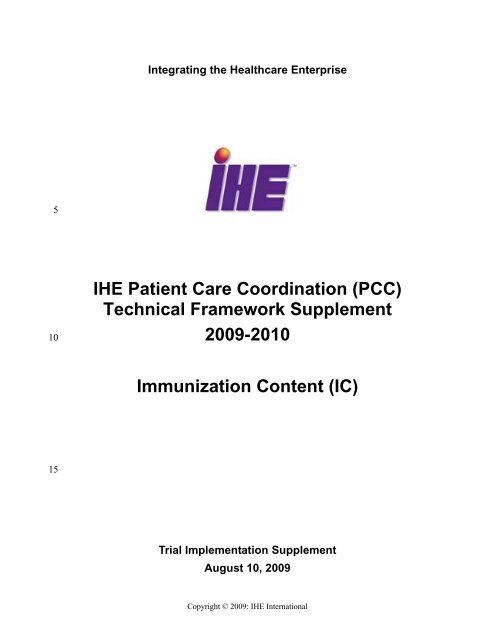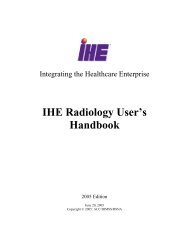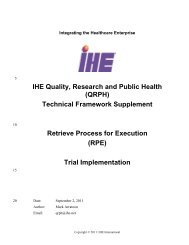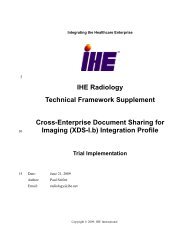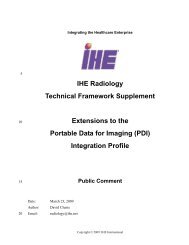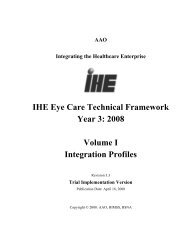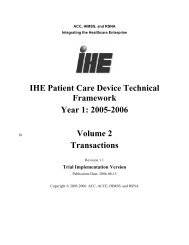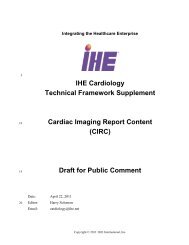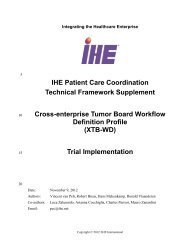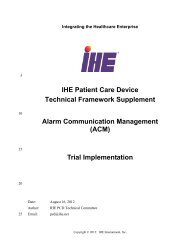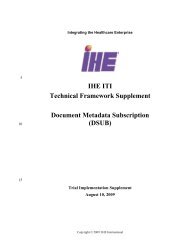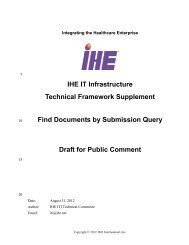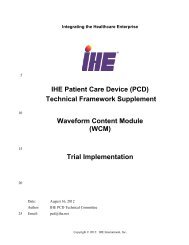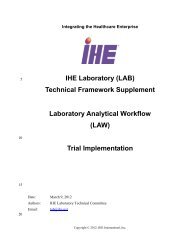Immunization Content - IHE
Immunization Content - IHE
Immunization Content - IHE
You also want an ePaper? Increase the reach of your titles
YUMPU automatically turns print PDFs into web optimized ePapers that Google loves.
Integrating the Healthcare Enterprise<br />
5<br />
10<br />
<strong>IHE</strong> Patient Care Coordination (PCC)<br />
Technical Framework Supplement<br />
2009-2010<br />
<strong>Immunization</strong> <strong>Content</strong> (IC)<br />
15<br />
Trial Implementation Supplement<br />
August 10, 2009<br />
Copyright © 2009: <strong>IHE</strong> International
<strong>IHE</strong> PCC Technical Framework Supplement – <strong>Immunization</strong> <strong>Content</strong> (IC)<br />
________________________________________________________________________<br />
20 Foreward<br />
25<br />
30<br />
This page is standard language for all <strong>IHE</strong> supplements. The Introduction section<br />
following will list all other <strong>IHE</strong> documents that are modified by this supplement. This<br />
document is a supplement to the <strong>IHE</strong> Patient Care Coordination Technical Framework<br />
4.0. The technical framework can be found at<br />
http://www.ihe.net/Technical_Framework/index.cfm#pcc.<br />
This and all <strong>IHE</strong> supplements are written as changes to a base document. The base<br />
document is normally one or more <strong>IHE</strong> Final Text documents. Supplements tell a<br />
technical editor and the reader how to modify the final text (additions, deletions, changes<br />
in wording). In order to understand this supplement, the reader needs to read and<br />
understand all of the base documents that are modified by this supplement.<br />
In this supplement you will see “boxed” instructions similar to the following:<br />
Replace Section X.X by the following:<br />
These “boxed” instructions are for the author to indicate to the Volume Editor how to<br />
integrate the relevant section(s) into the overall Technical Framework.<br />
35 This format means the reader has to integrate the base documents and the supplement.<br />
When the material in the supplement is considered ready for incorporation into the final<br />
text of the Technical Framework, the <strong>IHE</strong> committees will update the technical<br />
framework documents with the final text. Supplements are written in this format to avoid<br />
duplication material. This means that two <strong>IHE</strong> documents (one possibly final text, and the<br />
40 other a supplement) should not contain contradictory material.<br />
Text in this document is not considered final for the Technical Framework. It becomes<br />
Final Text only after the <strong>IHE</strong> PCC Technical Committee ballots the supplement (after<br />
testing) and agrees that the material is ready for integration with the existing Technical<br />
Framework documents.<br />
45 It is submitted for Trial Implementation starting August 10, 2009.<br />
Comments on this supplement may be submitted http://forums.rsna.org:<br />
1. Select the “<strong>IHE</strong>” forum<br />
2. Select Patient Care Coordination Technical Framework<br />
3. Select 2009-2010 Supplements for Public Comment<br />
50 4. Select <strong>Immunization</strong> Care Plan<br />
Please use the Public Comment Template provided there when starting your New Thread.<br />
Details about <strong>IHE</strong> may be found at: www.ihe.net<br />
Details about the <strong>IHE</strong> Patient Care Coordination may be found at:<br />
http://www.ihe.net/Domains/index.cfm<br />
55 Details about the structure of <strong>IHE</strong> Technical Frameworks and Supplements may be<br />
found at: http://www.ihe.net/About/process.cfm and<br />
http://www.ihe.net/profiles/index.cfm<br />
_____________________________________________________________________<br />
2009-08-10 2 Copyright @ 2009: <strong>IHE</strong> International
60<br />
65<br />
70<br />
<strong>IHE</strong> PCC Technical Framework Supplement – <strong>Immunization</strong> <strong>Content</strong> (IC)<br />
________________________________________________________________________<br />
Introduction<br />
This supplement is written for Trial Implementation. It is written as changes to the<br />
documents listed below. The reader should have already read and understood these<br />
documents:<br />
1. PCC Technical Framework Volume 1, Revision 5.0<br />
2. PCC Technical Framework Volume 2, Revision 5.0<br />
This supplement also references other documents 1 . The reader should have already read<br />
and understood these documents:<br />
1. IT Infrastructure Technical Framework Volume 1, Revision 6.0<br />
2. IT Infrastructure Technical Framework Volume 2, Revision 6.0<br />
3. The Patient Identifier Cross-Reference (PIX) and Patient Demographic Query<br />
(PDQ) HL7 v3 Supplement to the IT Infrastructure Technical Framework.<br />
4. HL7 and other standards documents referenced in Volume 1 and Volume 2<br />
5. Dilbert 2.0: 20 Years of Dilbert by Scott Adams, ISBN-10: 0740777351, ISBN-<br />
13: 978-0740777356<br />
This supplement defines the <strong>Immunization</strong> <strong>Content</strong> (IC) profile provided for trial<br />
implementation.<br />
1 The first three documents can be located on the <strong>IHE</strong> Website at<br />
http://www.ihe.net/Technical_Framework/index.cfm#IT. The remaining documents can be obtained from<br />
their respective publishers.<br />
_____________________________________________________________________<br />
2009-08-10 3 Copyright @ 2009: <strong>IHE</strong> International
<strong>IHE</strong> PCC Technical Framework Supplement – <strong>Immunization</strong> <strong>Content</strong> (IC)<br />
________________________________________________________________________<br />
75<br />
80<br />
85<br />
90<br />
95<br />
100<br />
105<br />
110<br />
115<br />
<strong>Content</strong>s<br />
<strong>Immunization</strong> <strong>Content</strong> (IC)............................................................................................................. 1<br />
Foreward ......................................................................................................................................... 2<br />
Introduction..................................................................................................................................... 3<br />
<strong>Content</strong>s 4<br />
Open Issues for <strong>Immunization</strong> <strong>Content</strong>................................................................................. 4<br />
Closed issues for <strong>Immunization</strong> <strong>Content</strong> .............................................................................. 5<br />
Abstract........................................................................................................................................... 6<br />
Glossary .......................................................................................................................................... 7<br />
X The <strong>Immunization</strong> <strong>Content</strong> Profile (IC) .................................................................................. 9<br />
X.1 Use Cases .......................................................................................................................... 10<br />
X.1.1 Use Case 1: <strong>Immunization</strong> Information System Participation....................................... 10<br />
X.1.2 Use Case 2: <strong>Immunization</strong> Yellow Card................................................................... 11<br />
X.1.3 Use Case 3: Personal Health Record......................................................................... 11<br />
X.1.4 Use Case 4: Vaccine Forecast ................................................................................... 11<br />
X.2 Actors/Transaction ............................................................................................................ 11<br />
X.3 Options ......................................................................................................................... 12<br />
X.3.1 View Option .............................................................................................................. 12<br />
X.3.2 Document Import Option ..........................................................................................<br />
X.3.3 Section Import Option...............................................................................................<br />
X.3.4 Discrete Data Import Option .....................................................................................<br />
X.4 Coded Terminologies ...................................................................................................<br />
X.5 Process Flow .....................................................................................................................<br />
X.6 <strong>Immunization</strong> <strong>Content</strong> Module .........................................................................................<br />
X.7 Grouping ...........................................................................................................................<br />
X.7.1 Cross Enterprise Document Sharing, Media Interchange and Reliable<br />
Messages...............................................................................................................<br />
X.7.2 Request for Clinical Guidance ..................................................................................<br />
X.7.2.1 Care Manager Requirements ..............................................................................................<br />
X.7.2.2 Decision Support Service Requiremnts..............................................................................<br />
X.7.3 Notification of Document Availability (NAV) .........................................................<br />
X.7.4 Document Digital Signature (DSG) ..........................................................................<br />
Volume II......................................................................................................................................<br />
3.1 <strong>IHE</strong> Format Codes .............................................................................................................<br />
6.1.1.Y <strong>Immunization</strong> <strong>Content</strong> Specification1.3.6.1.4.1.19376.1.5.3.1.1.18.1.2 ..........................<br />
Open Issues for <strong>Immunization</strong> <strong>Content</strong><br />
1. <strong>Immunization</strong> <strong>Content</strong> needs to be able to specify one or more immunization<br />
guidelines to be used. For example, the request may indicate that the patient is<br />
to be immunized using Standard CDC / ACIP population guidelines, or travel<br />
guidelines for travel to SE Asia. How should these guidelines be referenced<br />
12<br />
12<br />
13<br />
13<br />
13<br />
14<br />
17<br />
17<br />
17<br />
18<br />
18<br />
18<br />
18<br />
19<br />
19<br />
19<br />
_____________________________________________________________________<br />
2009-08-10 4 Copyright @ 2009: <strong>IHE</strong> International
<strong>IHE</strong> PCC Technical Framework Supplement – <strong>Immunization</strong> <strong>Content</strong> (IC)<br />
________________________________________________________________________<br />
2. Value and extent of a “selection of rank-ordered immunization care plans” that<br />
might be returned to support various combinations of vaccine availability and /<br />
or limitations on the number of shots to be given in any single visit<br />
120<br />
125<br />
130<br />
135<br />
Closed issues for <strong>Immunization</strong> <strong>Content</strong><br />
1. Need specific codes to use for “Intent” of IC Domain <strong>Content</strong> in the RCG-IC<br />
response for both “Validated” history content, and for “Proposed” immunization<br />
care plan. The use of IC for both “validated history” and “immunization care<br />
plan” in the response to the service call needs to be examined carefully to see if<br />
there are any other standard vocabulary items that might need new codes.<br />
These were established by the <strong>Immunization</strong> Recommendation entry, and for<br />
“validated history”, in the alert entry.<br />
2. We agreed that invalid doses would not have the dose number flagged to<br />
indicate that they are invalid, but would instead have an observation indicating<br />
the administrative status of “invalid” with the relevant reasons. This<br />
observation needs a code (LOINC).<br />
See the alert entry.<br />
3. The PCC <strong>Immunization</strong> <strong>Content</strong> Profile Supplement needs to be changed to<br />
specify additional ActCode values or MoodCode values to support “validated”<br />
history, and “proposed” vaccine forecast / immunization Care Plan.<br />
_____________________________________________________________________<br />
2009-08-10 5 Copyright @ 2009: <strong>IHE</strong> International
<strong>IHE</strong> PCC Technical Framework Supplement – <strong>Immunization</strong> <strong>Content</strong> (IC)<br />
________________________________________________________________________<br />
140<br />
Abstract<br />
Add the following bullet to PCC TF-1:2.7 History of Annual Changes<br />
• <strong>Immunization</strong> <strong>Content</strong> Profile (IC) – The <strong>Immunization</strong> <strong>Content</strong> Profile defines<br />
standard immunization data content for <strong>Immunization</strong> Information Systems (IISs),<br />
other public health systems, electronic medical records (EMR) systems, Health<br />
Information Exchanges, and others wishing to exchange immunization data<br />
electronically in a standard format.<br />
_____________________________________________________________________<br />
2009-08-10 6 Copyright @ 2009: <strong>IHE</strong> International
<strong>IHE</strong> PCC Technical Framework Supplement – <strong>Immunization</strong> <strong>Content</strong> (IC)<br />
________________________________________________________________________<br />
145<br />
150<br />
155<br />
160<br />
165<br />
170<br />
Glossary<br />
Add the following terms to the Glossary<br />
Adverse Event – An Adverse Event (AE) is any unfavorable and unintended diagnosis,<br />
symptom, sign (including an abnormal laboratory finding), syndrome or disease which<br />
either occurs during the study, having been absent at baseline, or if present at baseline,<br />
appears to worsen<br />
2 .<br />
Antigen – A component of a disease-causing agent that stimulates an immune response.<br />
More commonly, the disease which a vaccine is supposed to protect against. In the<br />
context of immunization, the latter is the meaning of interest. 3<br />
Combination Vaccine – A vaccine product containing antigens to more than one<br />
disease. Combination vaccines are commonly used to reduce the number of “needle<br />
sticks” required to give multiple vaccines at the same time. A combination vaccine is<br />
effectively the same thing as a Multiple Antigen Vaccine or a Poly-valent Vaccine.<br />
Contraindication – Any medical, environmental, genetic, or other condition that makes<br />
a treatment inadvisable. Contraindications include increased likelihoods of a serious<br />
Adverse Events, reduced effectiveness of treatment, or duplicative therapies.<br />
Dose of Antigen / Vaccine Component – <strong>Immunization</strong> CDS will analyze an existing<br />
immunization history by vaccine component, or doses of antigen, in order to build a<br />
proposed immunization care plan (ICP).<br />
Dose of Vaccine / Administered Dose – This is a quantity of medication or vaccine<br />
substance that is administered as a single shot. It will contain one or more doses of<br />
antigens. <strong>Immunization</strong> histories are typically recorded in terms of administered doses of<br />
vaccine, rather than doses of antigens.<br />
Guidelines – Systematically developed statements to assist practitioner and patient<br />
decisions about appropriate health care for specific clinical circumstances 4 .<br />
<strong>Immunization</strong> Recommendation –A set of proposed immunizations to be given to a<br />
patient, including the dates to give them. The recommendation may be general, or it may<br />
be focused on a particular disease (such as an influenza pandemic) or a particular risk<br />
situation (such as travel to places with high risk factors for certain diseases).<br />
2 Adapted from the NINDS Glossary of Clinical Research Terms, Last updated November 24, 2008,<br />
retrieved from http://www.ninds.nih.gov/research/clinical_research/basics/glossary.htm<br />
3 From the HL7 Glossary, retrieved from<br />
http://www.hl7.org/v3ballot2009may/html/help/glossary/glossary.htm<br />
4 Field MJ, Lohr KN. Guidelines for Clinical Practice: from development to use. Washington DC: National<br />
Academic Press, 1992. Retrieved from<br />
http://www.nap.edu/openbook.phprecord_id=1863&page=27#p200063cf8960027001<br />
_____________________________________________________________________<br />
2009-08-10 7 Copyright @ 2009: <strong>IHE</strong> International
175<br />
180<br />
185<br />
190<br />
195<br />
<strong>IHE</strong> PCC Technical Framework Supplement – <strong>Immunization</strong> <strong>Content</strong> (IC)<br />
________________________________________________________________________<br />
<strong>Immunization</strong> Information System (IIS) – A software system designed to collect all<br />
information about immunizations given to a certain population. An IIS is typically<br />
funded or sponsored by a Public Health Department or Ministry.<br />
<strong>Immunization</strong> Interval – A measure of the interval between doses of antigens. For<br />
maximum effectiveness against the targeted disease, many vaccines must have booster<br />
shots given after the initial dose. The recommended interval varies by vaccine. In most<br />
cases, administration of a vaccine with less than the minimum immunization interval<br />
reduces the effectiveness of the vaccine, and one that is substantially longer than the<br />
recommended interval exposes a person to a higher risk of contracting the disease during<br />
the period of delay.<br />
<strong>Immunization</strong> Recommendation – A collection of proposed immunizations and<br />
encounters which a provider may use to develop an immunization care plan. Also known<br />
as an <strong>Immunization</strong> or Vaccine Forecast.<br />
<strong>Immunization</strong> Registry – See <strong>Immunization</strong> Information System<br />
Ineffective Dose – This is a dose of administered vaccine or vaccine component which<br />
may be predictably less effective than desired, due to inadequate immunization interval,<br />
expired vaccine, concurrent administration of antibiotics, vaccine recall, improper<br />
vaccine storage, or other issues.<br />
Invalid Dose – See Ineffective Dose<br />
Multiple Antigen Vaccine see Combination Vaccine.<br />
Precaution – A statement indicating any medical, environmental, genetic, or other<br />
condition that may increase the likelihood of an Adverse Event, or reduce the<br />
effectiveness of the medication or immunization. A clinician should review the risks and<br />
weigh them against the benefits of the vaccine before deciding whether or not to proceed<br />
with the immunization.<br />
Vaccine – This is a substance designed to be administered to a person in order provide<br />
protection against future disease. See also Combination Vaccine.<br />
_____________________________________________________________________<br />
2009-08-10 8 Copyright @ 2009: <strong>IHE</strong> International
<strong>IHE</strong> PCC Technical Framework Supplement – <strong>Immunization</strong> <strong>Content</strong> (IC)<br />
________________________________________________________________________<br />
Add Section X below to the end of Volume I preceding the Appendixes and Glossary<br />
200<br />
205<br />
210<br />
215<br />
X The <strong>Immunization</strong> <strong>Content</strong> Profile (IC)<br />
The <strong>Immunization</strong> <strong>Content</strong> Profile (IC) provides a standard document to exchange<br />
immunization data. It is intended to facilitate the exchange of immunization data among<br />
multiple systems belonging to a single or to multiple organizations. Data exchange with<br />
and among the installed base of U.S. <strong>Immunization</strong> Information System (IIS) base was a<br />
critical consideration in formulating this profile. However, its intention is to go beyond<br />
data exchange among IISs, and facilitate immunization data exchange on a healthcare<br />
information network that includes electronic medical record (EMR) systems, Health<br />
Information Exchanges, other public health systems, Personal Health Record (PHR)<br />
systems, and other stakeholder systems. Thus, the profile specifies common data formats<br />
for exchanging immunization data only, or for exchanging immunization data along with<br />
medical summary data needed for the overall care of a patient related to immunizations.<br />
To accomplish this, IC includes a history of administered vaccines with such details as lot<br />
number, who administered the shot, and so forth, and handles immunization as well as<br />
other information related to the patient's care. For example, it includes medical history,<br />
medications, allergies, vital signs, and so forth.<br />
_____________________________________________________________________<br />
2009-08-10 9 Copyright @ 2009: <strong>IHE</strong> International
<strong>IHE</strong> PCC Technical Framework Supplement – <strong>Immunization</strong> <strong>Content</strong> (IC)<br />
________________________________________________________________________<br />
X.1 Use Cases<br />
The following progression of use cases is illustrated in the drawing below<br />
220<br />
225<br />
Users<br />
1<br />
1<br />
Users<br />
Illinois<br />
230<br />
O’Hare Airport<br />
Hospital Clinic<br />
1<br />
Vaccine<br />
Forecast<br />
2<br />
235<br />
Users<br />
4<br />
Storefront Clinic<br />
Pediatrician<br />
PHR<br />
240<br />
3<br />
245<br />
Indiana HIE<br />
250<br />
255<br />
X.1.1 Use Case 1: <strong>Immunization</strong> Information System<br />
Participation<br />
Various provider organizations - airport flu shot clinics, storefront vaccine clinics, and<br />
hospital vaccine clinics - wish to submit immunization histories for patients to a regional<br />
<strong>Immunization</strong> Information System (IIS) with appropriate patient consent. The provider IT<br />
departments configure HL7 Version 2.3.1 connections with the IIS. Each time<br />
immunizations are recorded, records of the administered vaccines are automatically sent<br />
to the IIS using an HL7 version 2.3.1 standard format. This is representative of the<br />
present-state use case in the U.S.<br />
_____________________________________________________________________<br />
2009-08-10 10 Copyright @ 2009: <strong>IHE</strong> International
260<br />
265<br />
270<br />
275<br />
280<br />
285<br />
290<br />
295<br />
<strong>IHE</strong> PCC Technical Framework Supplement – <strong>Immunization</strong> <strong>Content</strong> (IC)<br />
________________________________________________________________________<br />
X.1.2 Use Case 2: <strong>Immunization</strong> Yellow Card<br />
A pediatrician's office produces official immunization records (sometimes called "Yellow<br />
Card") for patients. The provider electronic medical record (EMR) system retrieves<br />
demographic information and records of immunization its immunization repository. To<br />
supplement its records with immunizations that the patient may have received from other<br />
providers, it queries the regional <strong>Immunization</strong> Information System (IIS). It passes the<br />
immunization content to a software module or service that prints the information in the<br />
official Yellow Card format.<br />
X.1.3 Use Case 3: Personal Health Record<br />
The provider wishes to make the assembled immunization information available in the<br />
patient's Personal Health Record (PHR). The pediatrician's office EMR system includes<br />
the retrieved immunization information in its complete care provision information about<br />
the patient. The standard Care Provision information contains current conditions,<br />
allergies and past adverse events, medications, vital signs, past medical history such as<br />
disease history, and so forth, in addition to immunizations. Knowing that the patient also<br />
has visited providers in a neighboring state, the EMR system queries the neighboring<br />
state's Health Information Exchange (HIE) to retrieve additional care provision<br />
information in a standard format. Since the neighboring state IIS is also part of the HIE,<br />
the retrieved information also includes immunizations. The pediatrician's office EMR<br />
system combines the retrieved and local information and sends it to the provider's PHR<br />
system in a standard format.<br />
X.1.4 Use Case 4: Vaccine Forecast<br />
The pediatrician's office wishes to run an automated Clinical Decision Support Service to<br />
calculate which immunizations are due on the next visit, and to assist with<br />
reminder/recall. The service may be integrated within the EMR or may be accessed<br />
externally using a web service interface. The service accepts a standard XML-based<br />
payload in <strong>Immunization</strong> <strong>Content</strong> format. The pediatrician's EMR system submits the<br />
patients Care Provision data that it has previously assembled to the Clinical Decision<br />
Support Service and receives immunization recommendations in return. It records the<br />
care plan and uses it in reminder/recall.<br />
X.2 Actors/Transaction<br />
There are two actors in the IC profile, the <strong>Content</strong> Creator and the <strong>Content</strong> Consumer.<br />
<strong>Content</strong> is created by a <strong>Content</strong> Creator and is to be consumed by a <strong>Content</strong> Consumer.<br />
The sharing or transmission of content from one actor to the other is addressed by the<br />
appropriate use of <strong>IHE</strong> profiles described below, and is out of scope of this profile. A<br />
Document Source or a Portable Media Creator may embody the <strong>Content</strong> Creator Actor. A<br />
Document Consumer, a Document Recipient or a Portable Media Importer may embody<br />
the <strong>Content</strong> Consumer Actor. The sharing or transmission of content or updates from one<br />
actor to the other is addressed by the use of appropriate <strong>IHE</strong> profiles described in the<br />
section on <strong>Content</strong> Bindings with XDS, XDM and XDR.<br />
_____________________________________________________________________<br />
2009-08-10 11 Copyright @ 2009: <strong>IHE</strong> International
<strong>IHE</strong> PCC Technical Framework Supplement – <strong>Immunization</strong> <strong>Content</strong> (IC)<br />
________________________________________________________________________<br />
Figure X.2-1 IC Actor Diagram<br />
300<br />
X.3 Options<br />
Table X.3-1 IC Options<br />
Actor<br />
<strong>Content</strong> Consumer<br />
Option<br />
View Option (1)<br />
Document Import Option (1)<br />
Section Import Option (1)<br />
Discrete Data Import Option (1)<br />
Location in<br />
Vol 2<br />
PCC TF-2:3.0.1<br />
PCC TF-2:3.0.2<br />
PCC TF-2:3.0.3<br />
PCC TF-2:3.0.4<br />
Note 1: The Actor shall support at least one of these options.<br />
305<br />
310<br />
315<br />
320<br />
X.3.1 View Option<br />
This option defines the processing requirements placed on <strong>Content</strong> Consumers for<br />
providing access, rendering and management of the medical document. See the View<br />
Option in PCC TF-2:3.01 for more details on this option.<br />
A <strong>Content</strong> Creator Actor should provide access to a style sheet that ensures consistent<br />
rendering of the medical document content as was displayed by the <strong>Content</strong> Consumer<br />
Actor.<br />
The <strong>Content</strong> Consumer Actor shall be able to present a view of the document using this<br />
style sheet if present.<br />
X.3.2 Document Import Option<br />
This option defines the processing requirements placed on <strong>Content</strong> Consumers for<br />
providing access, and importing the entire medical document and managing it as part of<br />
the patient record. See the Document Import Option in PCC TF-2:3.02 for more details<br />
on this option.<br />
X.3.3 Section Import Option<br />
This option defines the processing requirements placed on <strong>Content</strong> Consumers for<br />
providing access to, and importing the selected section of the medical document and<br />
managing them as part of the patient record. See the Section Import Option in PCC TF-<br />
2:3.03 for more details on this option.<br />
_____________________________________________________________________<br />
2009-08-10 12 Copyright @ 2009: <strong>IHE</strong> International
325<br />
330<br />
335<br />
340<br />
345<br />
350<br />
355<br />
360<br />
<strong>IHE</strong> PCC Technical Framework Supplement – <strong>Immunization</strong> <strong>Content</strong> (IC)<br />
________________________________________________________________________<br />
X.3.4 Discrete Data Import Option<br />
This option defines the processing requirements placed on <strong>Content</strong> Consumers for<br />
providing access, and importing discrete data from selected sections of the medical<br />
document and managing them as part of the patient record. See the Discrete Data Import<br />
Option in PCC TF-2:3.04 for more details on this option.<br />
X.4 Coded Terminologies<br />
This profile supports the capability to record entries beyond the <strong>IHE</strong> required coding<br />
associated with structured data. Actors from this profile may choose to utilize coded data,<br />
but interoperability at this level requires an agreement between the communicating<br />
parties that is beyond the scope of this Profile.<br />
To facilitate this level of interoperability, the applications that implement actors within<br />
this profile shall provide a link to their HL7 conformance profile within their <strong>IHE</strong><br />
Integration statement. The conformance profile describes the structure of the information<br />
that they are capable of creating or consuming. The conformance profile shall state which<br />
templates are supported by the application implementing the profile Actors, and which<br />
vocabularies and/or data types are used within those templates. It should also indicate the<br />
optional components of the entry that are supported.<br />
An Example HL7 Conformance Profile is available to show how to construct such a<br />
statement. See the HL7 Refinement Constraint and Localization for more details on HL7<br />
conformance profiles.<br />
X.5 Process Flow<br />
There are several process flows for use of this content profile. The document oriented<br />
process flows are described in PCC TF-1:2.6 PCC Profiles Overview, where the content<br />
being exchanged is are documents conforming to the <strong>Immunization</strong> <strong>Content</strong> module.<br />
Another process flow uses this same content in a message used for clinical decision<br />
support. In this process flow, the content creator and content consumer actors are<br />
grouped with the Care Manager and Decision Support Actors of the Request for Clinical<br />
Guidance Profile.<br />
1. A Care Manager Actor acquires the medical and immunization history of a<br />
patient.<br />
2. The Care Manager Actor submits the relevant portions of this medical history<br />
along with the complete immunization history to the Decision Support Service<br />
using PCC-12 Request for Clinical Guideance Transaction.<br />
3. The Decision Support Service processes the result and returns a response to the<br />
Care Manager actor in that same transaction.<br />
4. The Care manager then applies the return information. How this information is<br />
used by the care manager is out of scope of this profile.<br />
This process flow is shown below in figure X.5-1.<br />
_____________________________________________________________________<br />
2009-08-10 13 Copyright @ 2009: <strong>IHE</strong> International
<strong>IHE</strong> PCC Technical Framework Supplement – <strong>Immunization</strong> <strong>Content</strong> (IC)<br />
________________________________________________________________________<br />
Care<br />
Manager<br />
Decision<br />
Support<br />
Service<br />
1) Acquire relevant Medical and <strong>Immunization</strong> History<br />
2 and 3) PCC-12 Request Clinical Guidance<br />
4) Process Response<br />
Figure X.5-1 Process Flow for Clinical Decision Support<br />
365<br />
370<br />
X.6 <strong>Immunization</strong> <strong>Content</strong> Module<br />
The <strong>Immunization</strong> <strong>Content</strong> Module is designed to provide a record of a patient's<br />
immunizations, document planned immunizations, provide details about the effectiveness<br />
of past immunizations, and to propose immunizations to be given as part of the overall<br />
care plan for the patient. This content module is fully defined in PCC TF-2:6.1.1.Y.<br />
The collection of information making up this content module is described in Table X.6-1<br />
below and discussed in more detail following it.<br />
_____________________________________________________________________<br />
2009-08-10 14 Copyright @ 2009: <strong>IHE</strong> International
<strong>IHE</strong> PCC Technical Framework Supplement – <strong>Immunization</strong> <strong>Content</strong> (IC)<br />
________________________________________________________________________<br />
Table X.6-1 <strong>Immunization</strong> Care Plan Data Elements<br />
Data<br />
Element /<br />
Section<br />
History of<br />
<strong>Immunization</strong>s<br />
Authors and<br />
Informants<br />
History of Past<br />
Illness<br />
Problem List<br />
Allergies and<br />
Intolerances<br />
Description<br />
This section lists of immunizations previously given to a patient. For each<br />
immunization given this list should include the date it was given, the name of the<br />
vaccine, a coded value for the vaccine, the lot number of the vaccine, the<br />
manufacturer of the vaccine, the provider giving the immunization, and any reactions<br />
or adverse events caused by the immunization, and the severity of those reactions, and<br />
if refused, the reason for the refusal.<br />
The source of the information may be the patient, parent or guardian, another<br />
provider, immunization registry, et cetera. The <strong>IHE</strong> PCC technical framework<br />
supports recording of the author or informant that provided the information being<br />
recorded in all coded entries.<br />
The history of past illnesses section includes clinical diagnoses relevant to<br />
immunizations. This may include prior illnesses that convey immunity or otherwise<br />
influence an immunization recommendation.<br />
The problem list includes those relevant to immunization recommendations, including<br />
current illnesses, conditions or risks (e.g., immunosuppression) that might be<br />
contraindications for providing an immunization.<br />
This section includes those allergies or intolerances to substances commonly used in<br />
vaccinations, e.g. egg albumin, et cetera, as well as allergies or intolerances to other<br />
medications or immunizations<br />
Opt<br />
R<br />
R<br />
R2<br />
R2<br />
R2<br />
Medications This is the list of relevant medications for the patient. R2<br />
Lab Results<br />
Coded Vital<br />
Signs<br />
Gestational Age<br />
at Birth<br />
Pregnancy<br />
History<br />
Advance<br />
Directives<br />
The laboratory results section may include information about antibody tests or titers<br />
that show that immunization has or has not been already conferred to a patient. This<br />
section may also include information about the results of point of care tests, such as a<br />
TB test.<br />
This section supports the recording of Vital signs such as height and weight. These<br />
enable dosing calculations to be performed. Other vital signs (e.g., temperature) may<br />
be included to enable the identification potential contraindications for immunization<br />
(e.g., fever).<br />
In the case of premature birth, immunizations are determined based upon the adjusted<br />
age of the infant. The gestational age at birth can be used to determine the adjusted<br />
age.<br />
This section may be present to include information about current pregnancy status for<br />
the patient, as this can also influence the type of vaccinations that may be proposed.<br />
This section includes advance directives that would influence the immunizations<br />
proposed for a patient.<br />
R2<br />
R2<br />
R2<br />
R2<br />
R2<br />
Comments This allows providers to add comments to the content. O<br />
<strong>Immunization</strong><br />
Recommendation<br />
<strong>Immunization</strong> recommendations indicate the immunizations that are proposed or<br />
intended for the patient and their schedule. It may reference specific guidelines to<br />
activate certain protocols (e.g., travel to a foreign country).<br />
C<br />
(See note<br />
1)<br />
Note 1:<br />
This data element is required when this content is used with the Request for Clinical Guidance (RCG)<br />
profile, and is required if known (R2) otherwise.<br />
_____________________________________________________________________<br />
2009-08-10 15 Copyright @ 2009: <strong>IHE</strong> International
375<br />
380<br />
385<br />
390<br />
395<br />
400<br />
405<br />
410<br />
415<br />
<strong>IHE</strong> PCC Technical Framework Supplement – <strong>Immunization</strong> <strong>Content</strong> (IC)<br />
________________________________________________________________________<br />
The material necessary to generate an immunization record is required of all instances of<br />
this content module. This record may be used to electronically exchange the<br />
immunization record of a patient as a clinical document.<br />
This content module includes information relevant to a clinical decision support service<br />
that reviews the immunization history and care plan present within it to make<br />
immunization recommendations. The immunization recommendations include those<br />
immunizations and encounters that are proposed and should identify the guidelines from<br />
which the recommendations are derived. Material needed for generating these<br />
recommendations is required if known in the data elements described in Table X.6-1<br />
above. Note also that some of this information may not be available (or provided) to the<br />
generating application.<br />
A content creator actor that implements this content profile shall be able to demonstrate<br />
that it can create a document that is sufficient for both uses. We note that not all uses of<br />
this content profile will require that level of output. There are cases where the data<br />
produced must be limited to a smaller set due to policy considerations. For example,<br />
when the document is used as immunization record necessary to for enrollment in a<br />
school, the content creator actor needs to be able to conform to local law, regulation, and<br />
policy regarding the information permitted in the exchange.<br />
Thus, content creators must be also configurable to generate the appropriate result.<br />
The immunization recommendations found in this content module support the<br />
specification of a proposed immunization. This is a proposal for treatment of a patient<br />
that can be reviewed by a decision support service, or could be output from a decision<br />
support service. This can also be described as being part of the intended plan of care for<br />
the patient. In this case, the intended treatments can be reviewed and potentially updated<br />
by a decision support service, or can serve as persistent documentation of the current plan<br />
for other uses (e.g., reminder/recall notices). The section template is described in more<br />
detail in section Error! Reference source not found.. The immunization<br />
recommendation entry details with the machine readable content and is described further<br />
in section Error! Reference source not found..<br />
The clinical statements about immunizations can be augmented with additional clinical<br />
statements to provide more detail on the immunization dosing. <strong>Immunization</strong> dosing can<br />
become complex due to the use of combination vaccines. Combination vaccines provide<br />
multiple antigens protecting against multiple disease conditions. A single immunization<br />
dose given to a patient can result in multiple antigens being used. It is the antigen doses<br />
that matter when trying to determine what immunizations are necessary for the patient.<br />
Guidelines vary by antigen with respect to the appropriate immunization interval and<br />
dose. One antigen within a combination vaccine may not be considered effective, while<br />
others could be. The Antigen Dose entry described in PCC TF-2:6.1.4.S to provide these<br />
details<br />
The information exchanged can include alerts used to inform clinicians about exceptional<br />
conditions. Alerts can be applied to existing immunization events to provide an<br />
evaluation of the effectiveness of those events. Alerts can identify other relevant clinical<br />
data that could impact the immunization care plan (e.g., pregnancy) or subsequent<br />
_____________________________________________________________________<br />
2009-08-10 16 Copyright @ 2009: <strong>IHE</strong> International
<strong>IHE</strong> PCC Technical Framework Supplement – <strong>Immunization</strong> <strong>Content</strong> (IC)<br />
________________________________________________________________________<br />
medical treatment (e.g., potential medication interactions). Alerts are described in more<br />
detail in PCC TF-2:6.1.4.R.<br />
420<br />
425<br />
430<br />
X.7 Grouping<br />
X.7.1 Cross Enterprise Document Sharing, Media Interchange and Reliable<br />
Messages<br />
Actors from the ITI XDS, XDM and XDR profiles embody the <strong>Content</strong> Creator and<br />
<strong>Content</strong> Consumer actors of this profile when it is used to share immunization histories<br />
and plans as clinical documents. A <strong>Content</strong> Creator or <strong>Content</strong> Consumer may be<br />
grouped with appropriate actors from the XDS, XDM or XDR profiles to exchange the<br />
content described therein. The metadata sent in the document sharing or interchange<br />
messages has specific relationships or dependencies (which we call bindings) to the<br />
content of the clinical document described in the content profile.<br />
The Patient Care Coordination Technical Framework defines the bindings to use when<br />
grouping the <strong>Content</strong> Creator of this Profile with actors from the <strong>IHE</strong> ITI XDS, XDM or<br />
XDR Integration Profiles.<br />
Table X.7-1 Bindings to XDS, XDR and XDM Profiles<br />
<strong>Content</strong> Binding Actor Optionality<br />
<strong>Immunization</strong><br />
<strong>Content</strong><br />
Medical Document Binding to XDS,<br />
XDM and XDR<br />
<strong>Content</strong><br />
Creator<br />
<strong>Content</strong><br />
Consumer<br />
R<br />
R<br />
435<br />
440<br />
445<br />
X.7.2 Request for Clinical Guidance<br />
To support the generation of immunization recommendations through a clinical decision<br />
support service, the Care Manager and Decision Support Service actors of the RCG<br />
profile shall each be grouped with the <strong>Content</strong> Creator and <strong>Content</strong> Consumer actors of<br />
this profile. This supports the exchange of <strong>Immunization</strong> <strong>Content</strong> containing the<br />
patient’s immunization history and care plan (from the Care Manager to the Decision<br />
Support Service Actor) and the updated immunization history and plan with<br />
immunization recommendations (from the Decision Support Service Actor to the Care<br />
Manager).<br />
Appendix F Transforming CDA Documents to Care Record Messages found in the<br />
Request for Clinical Guide Profile Supplement describes the model by which the<br />
<strong>Immunization</strong> <strong>Content</strong> document found in this profile can be transformed to the Care<br />
Record message used in the Request for Clinical Guidance transaction.<br />
_____________________________________________________________________<br />
2009-08-10 17 Copyright @ 2009: <strong>IHE</strong> International
450<br />
455<br />
460<br />
465<br />
470<br />
475<br />
480<br />
485<br />
<strong>IHE</strong> PCC Technical Framework Supplement – <strong>Immunization</strong> <strong>Content</strong> (IC)<br />
________________________________________________________________________<br />
This profile places specific requirements upon the Care Manager and Decision Support<br />
Service actors that are over an above those specified within the <strong>Immunization</strong> <strong>Content</strong><br />
Module itself. These are detailed below.<br />
X.7.2.1 Care Manager Requirements<br />
The Care Manager as the <strong>Content</strong> Creator shall create at least one proposed<br />
<strong>Immunization</strong> Recommendation Entry specifying the type of immunization being<br />
requested and may include a reference to the guidelines to apply.<br />
This module shall contain a required immunization recommendation. The proposed<br />
immunization shall contain a required proposal for immunization entry. The effective<br />
time of the proposal shall be present to indicates the time range of the request for<br />
immunizations to be given. The proposal may include a reference to one or more specific<br />
guidelines to indicate that this proposal is intended to comply with those guidelines.<br />
X.7.2.2 Decision Support Service Requiremnts<br />
The Decision Support Service Actor shall duplicate the content provided to it in the<br />
original request, annotating or augmenting that content as needed. It shall create<br />
immunization recommendations proposing the vaccinations that should be given for the<br />
proposed immunization, or record why no recommendation can be made.<br />
When immunizations are needed the immunization recommendation in the response<br />
should include at least one suggested list of encounters in which immunizations will be<br />
provided. Each encounter will contain one or more proposed immunization activities<br />
describing the vaccine to be given.<br />
X.7.3 Notification of Document Availability (NAV)<br />
A Document Source may provide the capability to issue a Send Notification Transaction<br />
per the ITI Notification of Document Availability (NAV) Integration Profile in order to<br />
notify one or more Document Consumer(s) of the availability of one or more documents<br />
for retrieval. One of the Acknowledgement Request options may be used to request from<br />
a Document Consumer that an acknowledgement should be returned when it has received<br />
and processed the notification. A Document Consumer should provide the capability to<br />
receive a Receive Notification Transaction per the NAV Integration Profile in order to be<br />
notified by Document Sources of the availability of one or more documents for retrieval.<br />
The Send Acknowledgement option may be used to issue a Send Acknowledgement to a<br />
Document Source that the notification was received and processed.<br />
X.7.4 Document Digital Signature (DSG)<br />
When a <strong>Content</strong> Creator Actor needs to digitally sign a document in a submission set, it<br />
may support the Digital Signature (DSG) <strong>Content</strong> Profile as a Document Source. When a<br />
<strong>Content</strong> Consumer Actor needs to verify a Digital Signature, it may retrieve the digital<br />
signature document and may perform the verification against the signed document<br />
content.<br />
_____________________________________________________________________<br />
2009-08-10 18 Copyright @ 2009: <strong>IHE</strong> International
<strong>IHE</strong> PCC Technical Framework Supplement – <strong>Immunization</strong> <strong>Content</strong> (IC)<br />
________________________________________________________________________<br />
Volume II<br />
490<br />
3.1 <strong>IHE</strong> Format Codes<br />
Add the following rows the PCC TF-2:3.1 <strong>IHE</strong> Format Codes<br />
Profile Format Code Media Type Template ID<br />
2009 Profiles<br />
<strong>Immunization</strong> <strong>Content</strong> (IC) urn:ihe:pcc:ic:2009 text/xml 1.3.6.1.4.1.19376.1.5.3.1.1.18.1.2<br />
Add the following section to the end of PCC TF-2:4.3 CDA Document <strong>Content</strong> Modules<br />
495<br />
500<br />
505<br />
6.1.1.Y <strong>Immunization</strong> <strong>Content</strong> Specification1.3.6.1.4.1.19376.1.5.3.1.1.18.1.2<br />
The immunization content module specifies the information that can appear within a<br />
clinical document or message to convey information about immunizations. When used<br />
within a clinical document, this specification has the usual requirements. When used<br />
within a message, the encoded clinical data must be present, but the sections need not be.<br />
Systems accessing this content through a message must be able to process these messages<br />
regardless of whether the sections are present.<br />
Appendix F Transforming CDA Documents to Care Record Messages found in the<br />
Request for Clinical Guide Profile Supplement 5 describes the model by which the<br />
document created using this content module can be transformed to the Care Record<br />
message used in the Request for Clinical Guidance transaction.<br />
6.1.1.Y.1 LOINC Code<br />
The LOINC code for this document is 11369-6 HISTORY OF IMMUNIZATIONS<br />
6.1.1.Y.2 Standards<br />
CDAR2 HL7 CDA Release 2.0<br />
CCD<br />
ASTM/HL7 Continuity of Care Document<br />
5 See http://www.ihe.net/Technical_Framework/index.cfm#pcc for the material contained within the<br />
Request for Clinical Guidance Supplement to the PCC Technical Framework.<br />
_____________________________________________________________________<br />
2009-08-10 19 Copyright @ 2009: <strong>IHE</strong> International
<strong>IHE</strong> PCC Technical Framework Supplement – <strong>Immunization</strong> <strong>Content</strong> (IC)<br />
________________________________________________________________________<br />
6.1.1.Y.4 Specification<br />
Data Element Name Opt Template ID Vol 2<br />
<strong>Immunization</strong>s R 1.3.6.1.4.1.19376.1.5.3.1.3.23 PCC TF-2:6.3.3.3.5<br />
Active Problems R2 1.3.6.1.4.1.19376.1.5.3.1.3.6 PCC TF-2:6.3.3.2.3<br />
History of Past Illness R2 1.3.6.1.4.1.19376.1.5.3.1.3.8 PCC TF-2:6.3.3.2.5<br />
Allergies and Other Adverse Reactions R2 1.3.6.1.4.1.19376.1.5.3.1.3.13 PCC TF-2:6.3.3.2.11<br />
Medications R2 1.3.6.1.4.1.19376.1.5.3.1.3.19 PCC TF-2:6.3.3.3.1<br />
Coded Results R2 1.3.6.1.4.1.19376.1.5.3.1.3.28 PCC TF-2:6.3.3.5.2<br />
Coded Vital Signs R2 1.3.6.1.4.1.19376.1.5.3.1.1.5.3.2 PCC TF-2:6.3.3.4.5<br />
Pregnancy History<br />
When present, the pregnancy history section<br />
shall contain a Pregnancy Observation using<br />
the 11449-6 PREGNANCY STATUS code<br />
from LOINC to indicate whether the patient is<br />
pregnant.<br />
R2 1.3.6.1.4.1.19376.1.5.3.1.1.5.3.4 PCC TF-2:6.3.3.2.18<br />
Coded Advance Directives R2 1.3.6.1.4.1.19376.1.5.3.1.3.35 PCC TF-2:6.3.3.6.6<br />
Simple Observation<br />
The gestational age at birth of the patient may<br />
be recorded using the <strong>IHE</strong> Simple Observation<br />
template with a code identifying this<br />
observation as the gestational age of the<br />
patient at birth. One such code supporting that<br />
interpretation from SNOMED CT is<br />
268477000 fetal gestation at delivery 6 . This<br />
observation may appear in any relevant<br />
section 7 .<br />
<strong>Immunization</strong> Recommendations<br />
The section may be present to document the<br />
schedule of vaccinations that are intended or<br />
proposed for the patient. When present the<br />
section shall include <strong>Immunization</strong> entries in<br />
intent or proposal mood describing the<br />
immunization plan. The section may include a<br />
reference to one or more specific guidelines in<br />
definition mood to indicate the guidelines<br />
being used.<br />
R2 1.3.6.1.4.1.19376.1.5.3.1.4.13 PCC TF-2:6.3.4.20<br />
C<br />
(see<br />
note 1<br />
1.3.6.1.4.1.19376.1.5.3.1.1.18.3.1<br />
PCC CDA Supplement<br />
2:6.3.3.6.13<br />
510<br />
Note 1:<br />
This section is conditionally required based upon the use of the content. When the content module<br />
appears within a clinical document is required if known. When used in a clinical decision support<br />
message it is required.<br />
6 This code used the preferred term “fetal gestation at delivery” and is a “neonate observable” which makes<br />
it more appropriate for a newborn than the “length of gestation at birth” which is a “measure of fetus”.<br />
7 For infants born prematurely that this may appear within the problem list section, but after a certain age, it<br />
might be considered history and so appear elsewhere (e.g. history of past illness).<br />
_____________________________________________________________________<br />
2009-08-10 20 Copyright @ 2009: <strong>IHE</strong> International
515<br />
<strong>IHE</strong> PCC Technical Framework Supplement – <strong>Immunization</strong> <strong>Content</strong> (IC)<br />
________________________________________________________________________<br />
6.1.1.Y.5 Conformance<br />
CDA Release 2.0 documents that conform to the requirements of this content module<br />
shall indicate their conformance by the inclusion of the appropriate <br />
elements in the header of the document. Please note that when instantiated as a document<br />
this content module must also conform to the <strong>IHE</strong> Medical Document specification found<br />
in PCC TF-2:6.1.1.1.<br />
This is shown in the sample document below.<br />
_____________________________________________________________________<br />
2009-08-10 21 Copyright @ 2009: <strong>IHE</strong> International
520<br />
525<br />
530<br />
535<br />
540<br />
545<br />
550<br />
555<br />
560<br />
565<br />
570<br />
575<br />
<strong>IHE</strong> PCC Technical Framework Supplement – <strong>Immunization</strong> <strong>Content</strong> (IC)<br />
________________________________________________________________________<br />
<br />
<br />
<br />
<br />
<br />
<br />
<strong>Immunization</strong> Detail<br />
<br />
<br />
<br />
:<br />
<br />
<br />
<br />
<br />
<br />
<br />
<br />
<br />
<br />
<br />
<br />
<br />
<br />
<br />
<br />
<br />
<br />
<br />
<br />
<br />
<br />
<br />
<br />
<br />
<br />
<br />
<br />
<br />
<br />
<br />
<br />
<br />
<br />
<br />
<br />
<br />
<br />
<br />
<br />
<br />
<br />
<br />
<br />
<br />
Figure 6.1.1.Y-1 Sample <strong>Immunization</strong> <strong>Content</strong> Document<br />
Update the <strong>Immunization</strong> Entry in PCC TF-2:6.1.4.17.12 to use the Product Entry<br />
directly, instead of through reference to consumable under medications.<br />
_____________________________________________________________________<br />
2009-08-10 22 Copyright @ 2009: <strong>IHE</strong> International
580<br />
<strong>IHE</strong> PCC Technical Framework Supplement – <strong>Immunization</strong> <strong>Content</strong> (IC)<br />
________________________________________________________________________<br />
6.1.4.17.12 <br />
The element shall be present, and shall contain a<br />
entry conforming to the Product Entry template found in<br />
PCC TF-2:6.14.19.<br />
Add the following to after section 6.4.4.17.21<br />
585<br />
6.4.4.17.22 <br />
This repeatable element shall be used if needed to record the antigen doses applicable to<br />
an immunization. It shall contain an Antigen Dose entry (templateId<br />
1.3.6.1.4.1.19376.1.5.3.1.4.12.1).<br />
_____________________________________________________________________<br />
2009-08-10 23 Copyright @ 2009: <strong>IHE</strong> International


